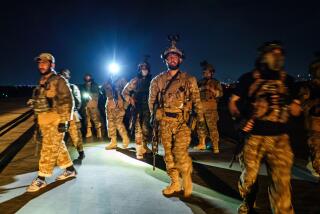We can still win
- Share via
As the Obama administration debates whether to stick with the counterinsurgency strategy for Afghanistan, opponents point to that nation’s flawed presidential election as a reason why this approach cannot work. Counterinsurgency is premised, they argue, on the presence of a legitimate national government that can win allegiance from local populations. Given credible allegations of rampant abuse in Afghanistan’s August election, President Hamid Karzai’s newly illegitimate government cannot play this role. As a result, the United States has little choice but to change strategies.
This argument is badly flawed. Electoral fraud will render our task in Afghanistan more difficult, but it does not make counterinsurgency impossible. On the contrary, a counterinsurgency approach -- and not a narrowly tailored mission focused solely on killing or capturing enemies -- remains the best path to success in Afghanistan.
To understand why, consider the analogous case of Iraq over the last three years. In January 2007, the “surge” of combat forces began as part of a new counterinsurgency strategy that emphasized clearing areas of fighters, holding that territory and building the infrastructure and institutions that had been so badly lacking -- just as Army Gen. Stanley A. McChrystal has proposed for Afghanistan.
At the time, Iraqi Prime Minister Nouri Maliki’s Shiite-led government was widely viewed as weak and sectarian. An overwhelming number of Sunni Arabs -- who formed the center of gravity of the insurgency -- rejected its legitimacy and had boycotted the December 2005 elections that brought it to power. The Maliki government had done little to allay these feelings; on the contrary, elements of its security forces participated in sectarian violence against Sunnis through 2006. As Sunnis became further alienated from the central government, the cycle of violence began to spiral out of control.
Army Gen. David H. Petraeus’ counterinsurgency strategy aimed to arrest this process by using American troops to protect the population -- predicting, correctly, that until basic security was restored in key neighborhoods and communities, extremists on both sides of the sectarian divide would continue to inflame the situation. With U.S. forces clearing and holding territory and demonstrating to the Sunnis that they had a reasonable alternative to Al Qaeda and its sectarian warfare, the extremists were sidelined. Security began to improve, and the political space necessary for reconciliation began to open.
Prospects for such an outcome in Afghanistan actually look better now than they did in Iraq in early 2007. To begin with, unlike Iraq -- where success hinged on persuading a critical mass of the Sunni Arab community to accept the bitter reality of a Shiite-led government -- no deep existential issue drives Afghans (primarily Pashtuns) into the arms of the insurgents.
In fact, according to polls and other evidence, the overwhelming majority of Afghans, including Pashtuns, remain hostile to the Taliban’s ideological agenda and unenthusiastic about a return to the medievalism that was inflicted on the country when it was last in power. The inroads the Taliban has made mainly reflect the failures and abuses of the Afghan government at the local level, not transcendent grievances about ethnic or sectarian divides.
For this reason, the national government in Afghanistan almost certainly retains greater legitimacy among the people than did the Iraqi government before things began to turn for the better there.
Secretary of Defense Robert M. Gates recently touched on this point. Despite the presidential election, he said, “the key is whether the Afghans believe that their government has legitimacy. And everything that I’ve seen in the intelligence and elsewhere indicates that remains the case.”
This is not to say that a stolen presidential election is meaningless. But our main goal should be helping the Afghan government work at the local level -- providing the marginal but tangible improvements in security, governance and prosperity that ordinary Afghans say they want, and stopping the corruption and abuses they personally contend with and resent.
Ironically, the greatest effect of Afghanistan’s botched election may be felt outside the country -- reinforcing doubts in the United States and Europe about whether a corrupt Afghan government really deserves our help. But this misses the point. We are in Afghanistan because its takeover by the Taliban would be catastrophic for American national interests. The Taliban seeks to achieve that goal by exploiting any gaps it can find between the government and the people. Our task is to see clearly the causes for these gaps and take the steps necessary to close them.
This is precisely what McChrystal spent upward of 60 pages explaining in his recent assessment. The counterinsurgency strategy he describes -- difficult and costly though it may be -- remains the best possible path to preventing the return of Afghanistan to a Taliban-dominated terrorist sanctuary.
More to Read
Get the L.A. Times Politics newsletter
Deeply reported insights into legislation, politics and policy from Sacramento, Washington and beyond. In your inbox twice per week.
You may occasionally receive promotional content from the Los Angeles Times.










